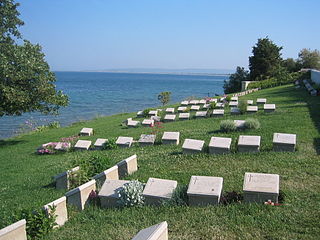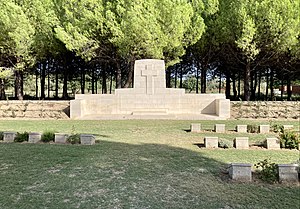
The Gallipoli peninsula is located in the southern part of East Thrace, the European part of Turkey, with the Aegean Sea to the west and the Dardanelles strait to the east.

The Gallipoli campaign was a military campaign in the First World War that took place on the Gallipoli peninsula, from 17 February 1915 to 9 January 1916. The Entente powers, Britain, France and Russia, sought to weaken the Ottoman Empire, one of the Central Powers, by taking control of the Ottoman straits. This would expose the Ottoman capital at Constantinople to bombardment by Allied battleships and cut it off from the Asian part of the empire. With Turkey defeated, the Suez Canal would be safe and a year-round Allied supply route could be opened through the Black Sea to warm-water ports in Russia.

Lancashire Landing Cemetery is a Commonwealth War Graves Commission cemetery located on the Gallipoli peninsula in Turkey. It contains the graves of some of the Allied troops killed during the Battle of Gallipoli.
Redoubt Cemetery is a Commonwealth War Graves Commission cemetery containing the remains of allied troops who died during the Battle of Gallipoli in Turkey. It is located near Krithia on the Gallipoli Peninsula.
Twelve Tree Copse Cemetery is a Commonwealth War Graves Commission cemetery containing the remains of Allied troops who died during the Gallipoli campaign. It is located about one kilometre (0.62 mi) south-west of Krithia on the Gallipoli Peninsula.

Beach Cemetery is a small Commonwealth War Graves Commission cemetery containing the remains of allied troops who died during the Battle of Gallipoli. It is located at Hell Spit, at the southern end of Anzac Cove on the Gallipoli Peninsula.

Shrapnel Valley Cemetery is a cemetery from World War I and is the second largest Commonwealth War Graves Commission Cemetery in the former Anzac sector of the Gallipoli Peninsula, Turkey, after Lone Pine Cemetery.

Quinn's Post Cemetery is a Commonwealth War Graves Commission cemetery from World War I in the former Anzac sector of the Gallipoli Peninsula, Turkey. The battles at Gallipoli, some of whose participating soldiers are buried at this cemetery, were an eight-month campaign fought by Commonwealth and French forces against Turkish forces in an attempt to force Turkey out of the war, to relieve the deadlock of the Western Front (France/Belgium) and to open a supply route to Russia through the Dardanelles and the Black Sea.
Shell Green Cemetery is a Commonwealth War Graves Commission Cemetery from World War I in the former Anzac sector of the Gallipoli Peninsula, Turkey for soldiers killed during the Gallipoli campaign. The eight-month campaign was fought by Commonwealth and French forces against Turkish forces in an attempt to force Turkey out of the war, to relieve the deadlock of the Western Front (France/Belgium) and to open a supply route to Russia through the Dardanelles and the Black Sea.
Hill 10 Cemetery is a Commonwealth War Graves Commission Cemetery in the former Suvla Bay sector of the Gallipoli Peninsula, Turkey. The battles at Gallipoli, some of whose participating soldiers are buried at this cemetery, was an eight-month campaign fought by Commonwealth and French forces against Turkish forces in an attempt to force Turkey out of the war, to relieve the deadlock of the Western Front (France/Belgium) and to open a supply route to Russia through the Dardanelles and the Black Sea.

Hill 60 Cemetery is a Commonwealth War Graves Commission cemetery dating from World War I at the Northern end of the former Anzac sector of the Gallipoli Peninsula, Turkey and the location of Hill 60 Memorial, one of four memorials on the peninsula which commemorate New Zealanders killed in the campaign but who have no known grave.

Johnston's Jolly Cemetery is a Commonwealth War Graves Commission cemetery containing the remains of some of the Allied troops who died during the Battle of Gallipoli.

New Zealand No.2 Outpost Cemetery is a small Commonwealth War Graves Commission cemetery containing the remains of some of the Allied troops who died during the Battle of Gallipoli.

Courtney's and Steel's Post Cemetery is a Commonwealth War Graves Commission cemetery located near ANZAC Cove on the Gallipoli peninsula in Turkey. It contains the graves of some of the former British Empire troops who died during the Gallipoli Campaign.
The Farm Cemetery is a Commonwealth War Graves Commission cemetery on the Gallipoli Peninsula in Turkey. It contains the remains of some of the soldiers killed during World War I in the Battles at Gallipoli.
Baby 700 Cemetery is a World War I Commonwealth War Graves Commission cemetery on the Gallipoli Peninsula in Turkey. It contains the bodies of some of the soldiers killed during the battles at Gallipoli. During an eight-month campaign in 1915, Commonwealth and French forces sought to force Turkey out of the war, which would relieve the deadlock on the Western Front and open a supply route to Russia through the Dardanelles and the Black Sea.
Lala Baba Cemetery is a Commonwealth War Graves Commission cemetery on the Gallipoli Peninsula in Turkey. It contains the remains of some of the soldiers killed during World War I during the battles at Gallipoli. This was an eight-month campaign fought by Commonwealth and French forces against Ottoman Empire forces to try to force the Ottoman Empire out of the war which it was hoped would open a supply route from the Mediterranean to Russia through the Dardanelles and Istanbul and to relieve the deadlock on the Western Front.

Lone Pine Cemetery is a Commonwealth War Graves Commission cemetery dating from World War I in the former Anzac sector of the Gallipoli Peninsula, Turkey and the location of the Lone Pine Memorial, one of five memorials on the peninsula which commemorate servicemen of the former British Empire killed in the campaign but who have no known grave.

The Helles Memorial is a Commonwealth War Graves Commission war memorial near Sedd el Bahr, in Turkey, on the headland at the tip of the Gallipoli peninsula overlooking the Dardanelles. It includes an obelisk which is over 30 metres (98 ft) high.












